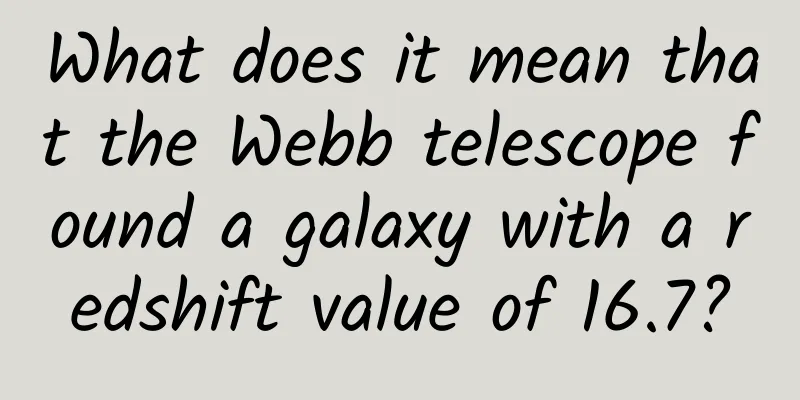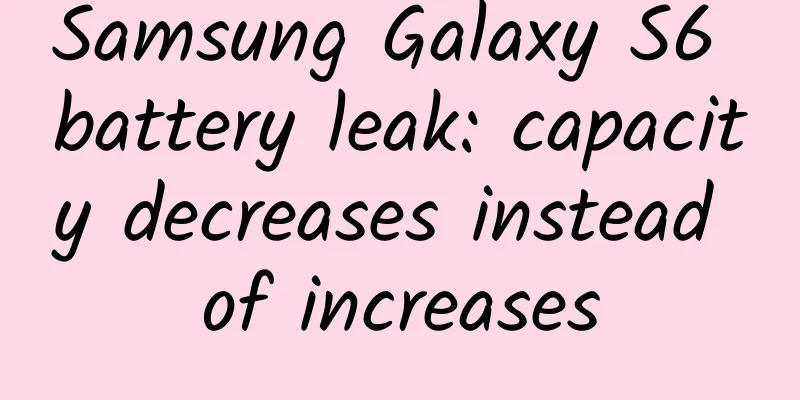What does it mean that the Webb telescope found a galaxy with a redshift value of 16.7?

|
The Webb Telescope (abbreviated as Webb) was officially launched in mid-July, and has already achieved several breakthroughs, indicating that this project, which cost more than $10 billion, has not been in vain. Shortly after its launch, there was news that it was hit by six micrometeorites, which made many people worry that Webb would be destroyed. Now these people can rest assured. Now Webb's discoveries are updated almost every day, such as detecting the atmospheric spectrum of an exoplanet more than 1,000 light-years away and discovering a galaxy 13.5 billion light-years away from us. This shows that Webb has surpassed the capabilities of its predecessor, the Hubble Space Telescope, which is about to retire. The galaxy with a redshift value of z=16.5, which has been hotly discussed in the media recently, has further confirmed that Weber lived up to expectations and pushed mankind's vision into deep space by a big step. So, what is the spectral redshift value? The so-called spectral redshift is the phenomenon of the Doppler effect of light, which is a special effect of waves. No matter what kind of waves, such as sound waves, gravitational waves, and light waves, there is a Doppler effect. This effect was discovered and proposed by the Austrian physicist and mathematician Christian Johann Doppler in 1842. In order to commemorate him, people call this effect the "Doppler effect." The first thing Doppler discovered was the effect of sound waves. When a train passed by him, he found that the whistle of the train coming towards him from a distance became louder, while the whistle became deeper as it passed by and moved away. Through his study of this physical phenomenon, he derived the theory of the Doppler effect, which states that when the wave source moves toward the observer, the wavelength becomes shorter and the frequency increases; conversely, when it moves away, the wavelength becomes longer and the frequency becomes lower. The faster the speed, the more obvious this effect is. Later people discovered that not only mechanical waves such as sound waves, but all waves, including light waves and gravitational waves, have the Doppler effect, and the Doppler effect of light waves is redshift and blueshift. This is based on the fact that visible light is not monochromatic, but composite light composed of multiple colors, roughly divided into seven colors: red, orange, yellow, green, cyan, blue and violet. Each color of light has a different wavelength and frequency. Red has the longest wavelength and the lowest frequency, while blue and violet have the shortest wavelength and the highest frequency. The human eye sees any object because light waves are transmitted to our retina. The Doppler effect of light shows that the wavelength of objects moving towards us becomes shorter and the frequency becomes higher, and the spectrum moves to the blue end, which is called blueshift. Conversely, the spectrum of objects moving away from us moves to the red end, which is called redshift. The formula for calculating the redshift value is: Z = (λ-λ0)/λ Here Z is a dimensionless quantity. A positive value of Z indicates a redshift, while a negative value indicates a blueshift. λ indicates the observed wavelength of the spectrum, and λ0 indicates the inherent wavelength of the spectrum. From this formula, we can see that the so-called spectrum redshift value Z is the wavelength of the observed spectrum minus the inherent wavelength of a spectrum divided by a multiple of this inherent wavelength. The inherent bands of the spectrum can be obtained in the laboratory. For example, when the electrons of a hydrogen atom transition from orbits 2, 3, and 4 to the ground state (orbit 1), the emitted radiation wavelengths are 121.57nm (nanometers, the same below), 102.57nm, and 97.254nm, respectively. This is the famous "Lyman line series", and is called Lyman α line, Lyman β line, Lyman γ line, and so on, respectively. Hydrogen is the most common element in the universe, accounting for about 75% of the visible mass of the universe. All stars are composed mainly of hydrogen, so observing the redshift of hydrogen's spectrum is the main method for observing distant celestial bodies. For example, the wavelength of a celestial body's Lyman alpha line is 1565.85nm, minus the intrinsic wavelength 121.57 obtained in the laboratory, and then divided by 121.57, we can get the redshift value of this galaxy as 11.88. Light with wavelengths of 121.57nm and 1565.88nm are not visible light, but belong to the ultraviolet and infrared ranges respectively. The wavelength range of ultraviolet light is between 10 and 400nm, and the wavelength range of infrared light is between 780nm and 1mm (millimeter, 1mm=1000000nm). The spectral lines emitted by a galaxy will become more and more redshifted as the universe expands, so the spectrum will be redshifted from invisible ultraviolet light to visible light, and then gradually move to the invisible infrared part. In this way, galaxies that are too far away cannot be seen using optical telescopes that observe in the visible light band. The strength of the Webb telescope is observing in the infrared band, and it can see the range of 600nm~28.8μm (micrometer, 1μm=1000nm). The relationship between spectral line redshift and distance At the beginning of the last century, American astronomer Hubble discovered the phenomenon of cosmic expansion, which means that all distant galaxies are moving away from us, isotropically, and the speed of their departure is proportional to the distance. That is to say, no matter from which direction you look, galaxies are moving away from us, and the farther away they are, the faster they are moving, in a proportional relationship. Hubble thus derived a law, expressed as V=HD. Here V represents the speed at which the galaxy is moving away from us; H represents the Hubble constant; and D represents the actual distance between the galaxy and us. The Hubble constant H refers to the speed at which a galaxy is moving away from us per second at a distance of Mpc (million parsecs, about 3.26 million light years). The scientific community has used various methods to measure the Hubble constant for decades, and the data obtained each time are not consistent, ranging from about 55 to 82.4 km/s. The current calculation of the age of the universe is 13.82 billion years, which is based on the Hubble constant of 67.8 km/s measured by the Planck satellite of the European Space Agency. Hubble's law implies a conversion relationship, that is, if we know the distance of a galaxy, we know the speed at which it is moving away from us; conversely, if we know the speed at which it is moving away from us, we know the distance of the galaxy from us. The redshift has a conversion relationship with Hubble's law, and the formula is: Z=HD/c. Here Z is the redshift, H is the Hubble constant, D is the actual distance of the observed galaxy, and c is the speed of light. According to the rule that the larger the redshift of the spectrum, the farther the distance, substituting the obtained redshift into the formula, we can get the distance between the observed galaxy and us. The Webb telescope discovered a galaxy with a redshift value of 16.7. What does this mean? The Webb telescope discovered a galaxy named GLASS-z13, z13 stands for a redshift of 13, which corresponds to light emitted about 300 million years after the Big Bang. Based on the age of the universe, which is 13.82 billion years old, this galaxy is about 13.5 billion light-years away. This is just the distance from us when the GLASS-z13 galaxy first emitted light. According to the law of cosmic expansion, the galaxy has now receded to a distance of 33 billion light years. Studies have shown that the mass of GLASS-z13 is only 1 billion times the mass of the sun, while the mass of the Milky Way is more than 1 trillion times the mass of the sun (including dark matter). This galaxy is only 0.1% of the Milky Way, indicating that it is an extremely small galaxy. The study also believes that this galaxy is only about 71 million years old, so it is a baby galaxy that has just formed or is in the process of forming. Before Webb discovered this galaxy, the most distant galaxy discovered in the universe was GN-z11. This galaxy with a redshift of 11.1 corresponds to a distance of 13.4 billion light-years from us, making it the most distant galaxy discovered by the Hubble Telescope. In other words, once the Webb telescope opened its eyes, it extended human vision by 150 million light years, which caused a sensation in the world's scientific community and media. But Webb's power is far more than that. Astronomers are now only studying GL-z13 as a candidate for further investigation. In the images sent back by Webb, astronomers also discovered several galaxies with even greater redshifts, one of which reached z>14, and at least three reached z>16, including one with z=16.7. These discoveries were published in a paper on the famous arXiv journal. What does this mean? It means that it is possible that the Webb telescope has photographed galaxies more than 13.6 billion light-years away from us, and these galaxies only looked like they did about 200 million years after the Big Bang. One of the most important tasks of the Webb telescope is to detect and study the first ray of light emitted by the Big Bang. According to the standard cosmological model, this light occurred 380,000 years after the Big Bang. The universe was cooled and diluted from extremely high temperature and extremely high density, and photons (electromagnetic waves) were able to decouple. From then on, the universe became transparent and visible. This ray of light has been cooling for 13.8 billion years since it burst out, and now exists in the entire space as cosmic microwave background radiation, with a temperature of about 2.73K (-270.42℃). Weber's mission lasts for 10 years. Now, he has only opened his eyes for half a month, and has seen what the universe looked like 13.6 billion years ago. And amazing discoveries continue to come. So will he eventually be able to see what the first ray of light looked like? We will have to wait and see. That’s all for today, welcome to discuss and comment. This work is the original copyright of Space-Time Communication. Please do not infringe or plagiarize. Thank you for your cooperation. |
Recommend
Why do some medicines cause coma when taken as pieces, but some are fine when taken as chewed?
Some time ago, a news story about a woman who fel...
Bighead carp: The ancients thought I was stupid, so they gave me this name.
[Expert] Bighead carp is an important freshwater ...
Is “avoiding spring” science or superstition?
China Science and Technology News Network, Februa...
Interaction between Silicon Valley and Chinese venture capital: Who will be the “buyer” of AR and VR?
There is no doubt that AR and VR are one of the h...
Group psychological counseling and treatment practice, technical analysis and application of authoritative teachers 60+ lessons 140 HD video full version
Practical group counseling and treatment, technica...
Why do I feel that online education platforms are unreliable?
Youcan wrote in the front: This article is an ana...
Baidu search promotion oCPC new platform operation manual
Baidu search promotion oCPC new platform operatio...
Marketing Promotion: How to write an integrated marketing communication case?
Many people look down on routines. But for newbie...
15 days of goddess body shaping, giving you a healthy and elegant body
15 days to shape your goddess body, give you a he...
Chukong Technology officially releases "One-stop solution for game development"
On February 2, 2015, Chukong Technology officiall...
There are so many advertising channels, how do you choose?
Faced with the intensified competition of product...
What would happen if we asked Papi Jiang to be in charge of market operations?
Internet celebrities appear every year, and they ...
iOS 7.1.1 surprise new changes: exciting
In addition to fixing bugs and Touch ID, iOS 7.1.1...









